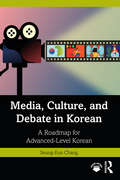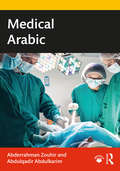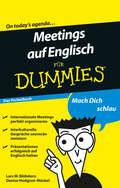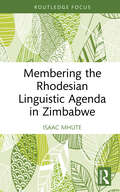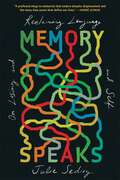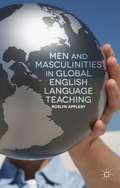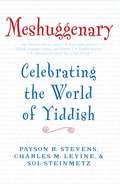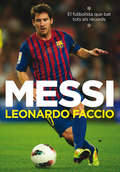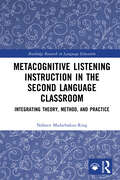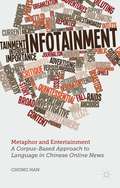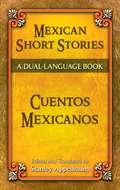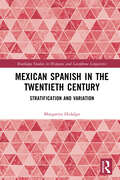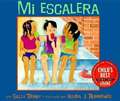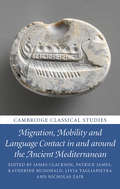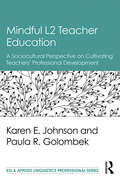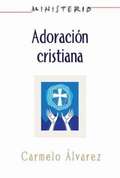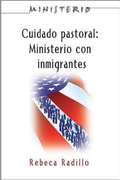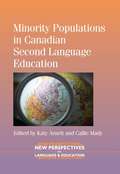- Table View
- List View
Media Arabic: Journalistic Discourse for Advanced Students of Arabic
by Jonas ElboustyMedia Arabic provides advanced students of Arabic with a range of engaging texts on controversial and contemporary topics that reflect the current social and political environment in the Middle East. Divided into ten thematic modules, each module includes three units based on a selection of authentic newspaper articles that dive deep into topics as diverse as climate change, racism, and corruption. Each unit contains comprehension and discussion questions as well as vocabulary lists, translation exercises, and creative writing exercises. Each topic also benefits from a curated selection of authentic news videos, which can be accessed at www.routledge.com/9781032044460. Ideal for use in Media Arabic courses, this book can also be used as a self-study resource for advanced level students.
Media, Culture, and Debate in Korean 미디어, 문화, 토론을 통한 고급 한국어 수업: A Roadmap for Advanced-Level Korean
by Seung-Eun ChangMedia, Culture, and Debate in Korean provides a roadmap for an advanced-level Korean course centered around media and culture and includes access to an archive of virtual media resources such as film, documentary, shows, newspaper, drama, music, and advertising. The book is designed to help students enhance their language skills and to deepen their knowledge and understanding of contemporary Korean society and culture through the analysis of authentic Korean media resources and debate. It addresses the cultural issues permeating Korean society that are rapidly transforming people’s perspectives, language, and lifestyle. These societal issues are discussed in the context of historical and psychological background, the struggle between tradition and changing values, positive and negative impact of the phenomenon, neologism, and potential solutions. This book can serve as a main textbook as well as a resource for an online class setting and can also be used in a traditional face-to-face class setting.
Medical Arabic
by Abderrahman Zouhir Abdulqadir AbdulkarimMedical Arabic is a valuable resource for students interested in learning medical Arabic at ACTFL level Advanced Low. Effective communication is essential in health care, and communication is most effective when both parties share a common language, therefore resulting in a comfortable relationship between health care provider and patient. This textbook is intended for those with prior knowledge of Arabic language and grammar. It is designed to provide students with the linguistic and cultural competencies and medical Arabic terminology necessary to communicate in medical settings such as a hospital, clinic, or a community health care facility. Students will be able to ask questions in Arabic and provide answers in common medical situations, conduct patient interviews, and understand a wider variety of possible responses from patients. The book provides clear explanations of medical vocabulary and concepts as they occur in the reading materials to encourage active interaction with the text. The book’s drills are designed as either in-class exercises or homework. The answer key for the book exercises is also provided as a downloadable e-resource. Written by dynamic authors who taught Arabic as a foreign language for several years and reviewed by physicians and professionals in the field, the book is an essential guide for students in medical school, biology, and other science majors. Students will find Medical Arabic more than merely a textbook but rather a pathway to enhance their communication skills effectively.
Medium of Instruction Policies: Which Agenda? Whose Agenda?
by James W. Tollefson Amy B. M. TsuiMedium of instruction policies in education have considerable impact not only on the school performance of students and the daily work of teachers, but also on various forms of social and economic (in)equality. In many multiethnic and multilingual countries, the choice of a language for the medium of instruction in state educational systems raises a fundamental and complex educational question: what combination of instruction in students' native language(s) and in a second language of wider communication will ensure that students gain both effective subject-content education, as well as the second-language skills necessary for higher education and employment? Beyond this educational issue of choice of language(s) of instruction, medium of instruction policies are also linked to a range of important sociopolitical issues, including globalization, migration, labor policy, elite competition, and the distribution of economic resources and political power. The contributors to this volume examine the tension between the educational agendas and other social and political agendas underlying medium of instruction policies in different countries around the world, and unravel the connections between these policies and the related, critically important educational, social, political, and economic issues. Medium of Instruction Policies: Which Agenda? Whose Agenda? is intended for scholars and specialists in education, language policy, sociolinguistics, applied linguistics, and language teaching, and is intended for use in graduate and advanced undergraduate courses on language education and language policy.
Meetings auf Englisch für Dummies (Für Dummies)
by Denise Hodgson-Möckel Dr. Lars M. BlöhdornSie wollen oder müssen Meetings mit internationalen Geschäftspartnern organisieren und fragen sich, wie das auf Englisch aussehen sollte? »Meetings auf Englisch für Dummies« hilft Ihnen, Besprechungen in englischer Sprache erfolgreich vorzubereiten und durchzuführen und dabei Kommunikationsklippen gekonnt zu umschiffen. Lars Blöhdorn und Denise Hodgson-Möckel bieten Ihnen viele hilfreiche Hinweise, praxisorientierte Beispiele und nützliche Hintergrundinformationen, damit Ihr Meeting zum Erfolg wird.
Membering the Rhodesian Linguistic Agenda in Zimbabwe
by Isaac MhuteMembering the Rhodesian Linguistic Agenda in Zimbabwe reports on a study carried out in Zimbabwe to ascertain the degree and effect of honouring the colonial linguistic agenda. The book employs an interpretivist philosophy and qualitative research approach that relies on participatory observations, interviewing purposively sampled informants and focus group discussions involving snowball sampled graduates. It was inspired by the Critical Language Policy Theory that considers language choice a critical determinant factor in how communities are administered politically, economically, socioculturally and educationally. It establishes that whereas linguistic imperialism meant to serve as the lifeblood of the Southern Rhodesian colonial machine, the former coloniser ensured coloniality in Zimbabwe by presenting the English language as a sacred media in political, economic, sociocultural and educational settings forever. The study establishes that the only way Zimbabwe and other such post-colonies could find redemption is by eradicating the sacredness of former colonisers’ languages by adding value to all their languages and the indigenous knowledge systems associated with them. It also demonstrates that the bigger the delay, the more is irretrievably lost together with custodians of the languages. This book will be informative for undergraduates, postgraduates and researchers in linguistics, communication, sociology, anthropology and history. It may also serve well as a resource to government researchers, politicians and other policymakers.
Memory Speaks: On Losing and Reclaiming Language and Self
by Julie SedivyFrom an award-winning writer and linguist, a scientific and personal meditation on the phenomenon of language loss and the possibility of renewal. As a child Julie Sedivy left Czechoslovakia for Canada, and English soon took over her life. By early adulthood she spoke Czech rarely and badly, and when her father died unexpectedly, she lost not only a beloved parent but also her firmest point of connection to her native language. As Sedivy realized, more is at stake here than the loss of language: there is also the loss of identity. Language is an important part of adaptation to a new culture, and immigrants everywhere face pressure to assimilate. Recognizing this tension, Sedivy set out to understand the science of language loss and the potential for renewal. In Memory Speaks, she takes on the psychological and social world of multilingualism, exploring the human brain’s capacity to learn—and forget—languages at various stages of life. But while studies of multilingual experience provide resources for the teaching and preservation of languages, Sedivy finds that the challenges facing multilingual people are largely political. Countering the widespread view that linguistic pluralism splinters loyalties and communities, Sedivy argues that the struggle to remain connected to an ancestral language and culture is a site of common ground, as people from all backgrounds can recognize the crucial role of language in forming a sense of self. Distinctive and timely, Memory Speaks combines a rich body of psychological research with a moving story at once personal and universally resonant. As citizens debate the merits of bilingual education, as the world’s less dominant languages are driven to extinction, and as many people confront the pain of language loss, this is badly needed wisdom.
Men and Masculinities in Global English Language Teaching
by Roslyn ApplebyThis book draws on a range of sources, including tales of castaways, fictional narratives, and interviews with teachers in conversation schools and universities in Japan, to explore many current concerns around teacher identity, gender, and intercultural sexuality in global English language teaching.
Meshuggenary
by Sol Steinmetz Payson R. StevensRumors that Yiddish is a dead language are greatly exaggerated. In fact, both the Yiddish language and culture are alive and well in America and elsewhere. English speakers take note: The Random House Dictionary and the Oxford English Dictionary both contain almost 100 Yiddish words that are now considered part of the English language. The impact of Yiddish culture is strongly felt in the films of Woody Allen, in Broadway shows like The Producers, and in television sitcoms such as The Nanny and Seinfeld in the tradition of the comic headliners of the Catskills. The world of Yiddish reaches out and embraces us in the literature of Isaac Bashevis Singer and Art Spiegelman, the culinary offerings of innumerable delicatessens, and the renewed popularity of klezmer music. Yiddish is rich and soulful, thick with pathos, full of humor and self-deprecating wit and sarcasm -- as a language it uniquely captures the essence of what, or who, it describes. If you've ever noshed on a bagel, or yelled at the schmuck who had the chutzpah to cut you off at the traffic light, you've been enriched and empowered by Yiddish. Beautifully designed and illustrated, Meshuggenary is a deeply researched and eclectic introduction to Yiddish language, culture, and history. It explores the basics of Yiddish vocabulary and grammar; proverbs, expressions, blessings, curses, and insults; and even the difference between Yiddish, Yinglish (Yiddish-origin words now part of English), and Yiddlish (words that sound Yiddish but aren't). There are chapters on Yiddish humor, literature, theater, and music; a who's who of Yiddish luminaries; and a captivating glimpse of the contributions of women to its literature and culture. So you shouldn't go hungry, there's a chapter on food with a tempting selection of family recipes. And if this little taste isn't enough to satisfy you, there's information on a host of books and Yiddish Web sites and Internet links. Erudite, accessible, highly informative, and enormously entertaining, Meshuggenary is an irresistible pleasure.
Messi
by Leonardo FaccioA la història del futbol, només quatre jugadors tenen plaça al primer esgraó: Pelé, Di Stéfano, Cruyff i Maradona. Des de fa quatre anys, largentí Messi truca amb insistència a la porta daquest club restringit i cada setmana les seves exhibicions el confirmen com lamo de la pilota. Una estrella daquestes dimensions es mereix més que lhabitual hagiografia o un pamflet morbós. En la millor tradició del periodisme narratiu, el que neix amb Gay Talese, Tom Wolfe o Norman Mailer, Leonardo Faccio ha dibuixat un perfil fascinant en tres temps del futbolista més famós del món, que amb només vint-i-quatre anys ha batut tots els rècords. Un noi tímid, petit i daparença fràgil, que sha convertit en la joia més valuosa de lespectacle més gran del món. Passin i llegeixin!
Messi
by Leonardo FaccioEn la historia del fútbol sólo cuatro jugadores tienen plaza en el primer escalón: Pelé, Di Stéfano, Cruyff y Maradona. Desde hace cuatro años, el argentino Leo Messi llama con insistencia a la puerta de ese restringido club y sus exhibiciones cada semana le confirman como el amo del balón. Una estrella de esta dimensión merece más que la habitual hagiografía o un panfleto morboso. En la mejor tradición del periodismo narrativo, el que nace con Gay Talese, Tom Wolfe o Norman Mailer, Leonardo Faccio ha dibujado un fascinante perfil en tres tiempos del futbolista más famoso del mundo, que con apenas 24 años ha roto todos los récords. Un chico tímido, pequeño y de apariencia frágil, que se ha convertido en la joya más valiosa del mayor espectáculo del mundo. Pasen y lean.
Messi
by Leonardo FaccioEl perfil definitivo del incomparable Lionel Messi, una de las más brillantes estrellas del fútbol internacional En la historia del fútbol sólo cuatro jugadores tienen plaza en el primer escalón: Pelé, Di Stéfano, Cruyff y Maradona. Desde hace cuatro años, el argentino Lionel Messi llama con insistencia a la puerta de ese restringido club, y sus exhibiciones cada semana le confirman como el amo del balón. Estrella del equipo de Barcelona, ganador del Balón de Oro y nombrado jugador del año por la FIFA, un atleta de esta dimensión merece más que la habitual hagiografía. En la mejor tradición del periodismo narrativo, Leonardo Faccio ha dibujado un fascinante perfil en tres tiempos del futbolista más famoso del mundo, que con apenas 24 años ha roto todos los récords. Todos los detalles --desde su familia y sus amistades hasta su lucha contra el déficit de la hormona del crecimiento que casi le costó su carrera futbolística-- se reúnen aquí para formar la biografía más completa de la estrella argentina escrita hasta la fecha. Un chico tímido, pequeño y de apariencia frágil, que se ha convertido en la joya más valiosa del mayor espectáculo del mundo. Pasen y lean.
Metacognitive Listening Instruction in the Second Language Classroom: Integrating Theory, Method, and Practice (Routledge Research in Language Education)
by Naheen Madarbakus-RingThis book addresses the gap between listening theory and practice by providing an outline of listening theory, offering practical listening methods, and presenting how metacognitive instruction can be integrated into real lesson practice. Applying these methods to teaching and learning can provide educators with the instructional guidance needed to offer their learners some tangibility in second language (L2) listening.Based on original research, the book includes descriptions and accounts of teachers’ listening classroom practices to explain their teaching priorities and their teaching decisions. Further, samples of listening lessons and learners’ accounts of their listening experience provide additional insights into learning from listening. This book emphasizes the challenges that both teachers and learners face in the listening classroom and suggests metacognitive instruction as a remedy for these listening difficulties. It also outlines a four-stage pedagogic cycle including listening tasks and an additional journal component that integrates traditional teaching approaches and contemporary metacognitive methods.This book is a useful resource for academics, scholars, educators, and curriculum designers in the field of applied linguistics, L2 language learning, and foreign language education.
Metaphor and Entertainment
by Chong HanMetaphor and Entertainment presents the very first, large-scale exploration of metaphor in Chinese online entertainment news, one of the most vibrant and controversial news genres in contemporary China.
Mexican Short Stories / Cuentos mexicanos: A Dual-Language Book
by Stanley AppelbaumGreatly influenced by Europe's nineteenth-century literary trends, Mexico's writers crafted some of the most phenomenal prose fiction in Spanish America. This collection offers a rich sampling of significant Mexican short stories published from 1843 to 1918. Nine different tales range from the realism of López Portillo's "Reloj sin dueño" and the modernismo saturating Gutiérrez Nájera's "La mañana de San Juan" to the historical accuracy of Riva Palacio's "Las mulas de Su Excelencia" and the vivid romanticism of "Amor secreto" by Manuel Payno, named the "father of Mexican short stories." Each story appears in its original Spanish text with expert English translations on each facing page. This dual-language edition features a fascinating new introduction and ample footnotes. An easy-reading pleasure for lovers of fine Spanish-language literature, it is also a valuable educational aid for students and teachers.
Mexican Spanish in the Twentieth Century: Stratification and Variation (Routledge Studies in Hispanic and Lusophone Linguistics)
by Margarita HidalgoMexican Spanish in the Twentieth Century explores the trends and patterns of sociolinguistic stratification and variation, providing a clearer understanding of linguistic variation in Mexican Spanish as spoken in the twentieth century.The connection between past and present is evidenced through language data on Mexican Spanish gathered from various sources. The historical background of the nineteenth and twentieth centuries is revisited from the standpoint of stratification, conflict, and economic adjustments that fit within the model of modernity. This book advances both theoretical and methodological applications deemed necessary to crafting new research perspectives in Latin American sociolinguistics and the sociology of language. Seminal literary samples of Mexican and Latin American literature are presented systematically to exemplify the presence and vitality of linguistic variables along with their historical and social cultural context, offering a comprehensible and digestible approach to this field of study.Mexican Spanish in the Twentieth Century is a comprehensive volume for students and researchers of Hispanic linguistics, dialectology, and sociolinguistics. It will appeal to readers with an interest in the diversity of Latin American Spanish.
Mi Mundo Estudios Sociales: La formación de nuestra nación
by James B. Kracht Linda Bennett Armando Cantú AlonzoNIMAC-sourced textbook
Mi llamado a China: La historia de un profesor
by Kenneth BostianUna historia real sobre el primer año de un profesor de inglés extranjero en China. Aprende todo sobre las personas y las historias sobre ellas con fotos reales de esa época. Aprende sobre los lugares, las cosas y las experiencias contadas a través de los ojos del profesor. Una autobiografía informativa de un año en una pequeña universidad china.
Migration, Mobility and Language Contact in and around the Ancient Mediterranean (Cambridge Classical Studies)
by Patrick James James Clackson Nicholas Zair Katherine McDonald Livia TagliapietraMigration, Mobility and Language Contact in and around the Ancient Mediterranean is the first volume to show the different ways in which surviving linguistic evidence can be used to track movements of people in the ancient world. Eleven chapters cover a number of case studies, which span the period from the seventh century BC to the fourth century AD, ranging from Spain to Egypt, from Sicily to Pannonia. The book includes detailed study of epigraphic and literary evidence written in Latin and Greek, as well as work on languages which are not so well documented, such as Etruscan and Oscan. There is a subject index and an index of works and inscriptions cited.
Mindful L2 Teacher Education: A Sociocultural Perspective on Cultivating Teachers' Professional Development (ESL & Applied Linguistics Professional Series)
by Karen E. Johnson Paula R. GolombekTaking a Vygotskian sociocultural stance, this book demonstrates the meaningful role that L2 teacher educators and L2 teacher education play in the professional development of L2 teachers through systematic, intentional, goal-directed, theorized L2 teacher education pedagogy. The message is resoundingly clear: Teacher education matters! It empirically documents the ways in which engagement in the practices of L2 teacher education shape how teachers come to think about and enact their teaching within the sociocultural contexts of their learning-to-teach experiences. Providing an insider’s look at L2 teacher education pedagogy, it offers a close up look at teacher educators who are skilled at moving L2 teachers toward more theoretically and pedagogically sound instructional practices and greater levels of professional expertise. First, the theoretical foundation and educational rationale for exploring what happens inside the practices of L2 teacher education are established. These theoretical concepts are then used to conduct microgenetic analyses of the moment-to-moment, asynchronous, and at-a-distance dialogic interactions that take place in five distinct but sometimes overlapping practices that the authors have designed, repeatedly implemented, and subsequently collected data on in their own L2 teacher education programs. Responsive mediation is positioned as the nexus of mindful L2 teacher education and proposed as a psychological tool for teacher educators to both examine and inform the ways in which they design, enact, and assess the consequences of their own L2 teacher education pedagogy.
Ministerio - Adoración cristiana: Christian Worship: The Theology and Practice of Protestants AETH
by Association for Hispanic Theological EducationEste libro examina el tema de la adoración cristiana desde el punto de vista del protestantismo y la diversidad dentro de este. Es en esta diversidad que se han configurado modelos distintos en la organización eclesiástica y ha resultado en una adoración marcadamente creativa y flexible. El autor nos guiará por el desarrollo histórico de esta adoración y expondrá algunos de los modelos básicos.Written in Spanish, this book examines the topic of the Christian worship and its diversity from the Protestant perspective. This diversity has contributed to the configuration of different worship models in the ecclesiastical organization that results in a flexible and creative worship. The author will guide us for the historic development of Christian worship and discuss some of the basic models.
Ministerio series (AETH) - Cuidado Pastoral (AETH) - Cuidado Pastoral (AETH) - Cuidado Pastoral (AETH) - Cuidado Pastoral: Ministerio con Inmigrantes: Pastoral Care - The Ministry Series
by Association for Hispanic Theological EducationLa experiencia migratoria suscita un sinnúmero de situaciones complejas que presentan un reto súbito e inesperado al liderazgo pastoral. En su tarea pastoral el líder se enfrenta diariamente con gran número de personas que reflejan y le recuerdan su propia condición, así como sus conflictos y dificultades, como inmigrante en muchos casos. Tal experiencia pude resultar agotadora y emocional y espiritualmente debilitante, debido a la identificación o sobreidentificación con las personas a quienes sirve. Este libro explora estas ideas y sus dinámicas.The immigration experience stirs up an endless number of complex situations that present a sudden and unexpected challenge to pastoral leadership. In their Hispanic ministerial task, every day, church leaders are faced people who share their struggles and conflicts – particularly immigrants. Effectively carrying out this ministry can be exhausting and emotional and spiritually debilitating, due to the unique difficulties this ministry faces. This book explores ideas and the dynamics of this ministry.
Minority Populations in Canadian Second Language Education
by Callie Mady Katy ArnettUntil now, the picture painted of French second language learning in Canada has tended to focus on successful French immersion. This volume offers a broader representation, in response to the demographic changes that have made the French language classroom a more complex place. Focusing on inclusion and language maintenance, the chapters discuss how a multilingual population can add the two official languages to their repertoire whilst maintaining their languages of origin/heritage; how the revitalization of Indigenous languages can best be supported in the language classroom, and how students with disabilities can be helped to successfully learn languages.

